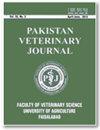求助PDF
{"title":"骆驼某些消化器官年龄相关解剖特征的定量评价","authors":"Anum Qureshi, Sarmad Rehan, M. Usman, Khizar Hayat, Zaima Umar, A. Sarfraz","doi":"10.29261/pakvetj/2019.129","DOIUrl":null,"url":null,"abstract":"Received: Revised: Accepted: Published online: August 04, 2019 December 07, 2019 December 09, 2019 December 31, 2019 This study was undertaken to explicate the age-related anatomical variations in the digestive system of dromedaries that might be very much helpful to understand its unique ability to digest different forages very efficiently than other ruminants. Digestive system organs were collected from 14 clinically healthy dromedaries of two age groups: young (1-2 years) or adult (>5 years) animals, after slaughtering for dissection and measurements. Before measuring and weighing various gastrointestinal sections, the mesentery, adipose tissue, and lymph nodes were removed. Studied parameters of upper digestive system included length and thickness of upper and lower lip along with philtrum, esophageal length and diameter. Furthermore, measurements of compound stomach viz rumino-reticulum length, height, diagonal and pillar thickness, both curvatures (dorsal and ventral), omasal and abomasum height, length and weight were also recorded. Lengths of the small and large intestines (small and large colon) were determined while containing digesta and morphological characters of liver (height, length and weight) were also estimated. An allometric regression model; Y (Model) = β (B.wt) × α was applied for bodyweight relation with digestive tract followed by analysis of means variance to compare the young and adult camels. Statistical analysis of anatomical parameters revealed a significant (P<0.05) improvement in the adult as compared to young dromedary group except the thickness of both (upper and lower) lip and philtrum for which non-significant (P>0.05) trend was recorded. Absolute weights of each organ were proved positively related to body weight, however, the relative weights were found negatively related to body weight. The age-related changes in the digestive system are obvious but quantification of these parameters may have a pivotal role to understand camel’s unique and efficient digestive system. ©2019 PVJ. All rights reserved","PeriodicalId":19845,"journal":{"name":"Pakistan Veterinary Journal","volume":" ","pages":""},"PeriodicalIF":3.8000,"publicationDate":"2020-04-01","publicationTypes":"Journal Article","fieldsOfStudy":null,"isOpenAccess":false,"openAccessPdf":"","citationCount":"2","resultStr":"{\"title\":\"Quantitative Evaluation of Age-Related Anatomical Characteristics of Selected Digestive Organs of Dromedary Camel\",\"authors\":\"Anum Qureshi, Sarmad Rehan, M. Usman, Khizar Hayat, Zaima Umar, A. Sarfraz\",\"doi\":\"10.29261/pakvetj/2019.129\",\"DOIUrl\":null,\"url\":null,\"abstract\":\"Received: Revised: Accepted: Published online: August 04, 2019 December 07, 2019 December 09, 2019 December 31, 2019 This study was undertaken to explicate the age-related anatomical variations in the digestive system of dromedaries that might be very much helpful to understand its unique ability to digest different forages very efficiently than other ruminants. Digestive system organs were collected from 14 clinically healthy dromedaries of two age groups: young (1-2 years) or adult (>5 years) animals, after slaughtering for dissection and measurements. Before measuring and weighing various gastrointestinal sections, the mesentery, adipose tissue, and lymph nodes were removed. Studied parameters of upper digestive system included length and thickness of upper and lower lip along with philtrum, esophageal length and diameter. Furthermore, measurements of compound stomach viz rumino-reticulum length, height, diagonal and pillar thickness, both curvatures (dorsal and ventral), omasal and abomasum height, length and weight were also recorded. Lengths of the small and large intestines (small and large colon) were determined while containing digesta and morphological characters of liver (height, length and weight) were also estimated. An allometric regression model; Y (Model) = β (B.wt) × α was applied for bodyweight relation with digestive tract followed by analysis of means variance to compare the young and adult camels. Statistical analysis of anatomical parameters revealed a significant (P<0.05) improvement in the adult as compared to young dromedary group except the thickness of both (upper and lower) lip and philtrum for which non-significant (P>0.05) trend was recorded. Absolute weights of each organ were proved positively related to body weight, however, the relative weights were found negatively related to body weight. The age-related changes in the digestive system are obvious but quantification of these parameters may have a pivotal role to understand camel’s unique and efficient digestive system. ©2019 PVJ. All rights reserved\",\"PeriodicalId\":19845,\"journal\":{\"name\":\"Pakistan Veterinary Journal\",\"volume\":\" \",\"pages\":\"\"},\"PeriodicalIF\":3.8000,\"publicationDate\":\"2020-04-01\",\"publicationTypes\":\"Journal Article\",\"fieldsOfStudy\":null,\"isOpenAccess\":false,\"openAccessPdf\":\"\",\"citationCount\":\"2\",\"resultStr\":null,\"platform\":\"Semanticscholar\",\"paperid\":null,\"PeriodicalName\":\"Pakistan Veterinary Journal\",\"FirstCategoryId\":\"97\",\"ListUrlMain\":\"https://doi.org/10.29261/pakvetj/2019.129\",\"RegionNum\":3,\"RegionCategory\":\"农林科学\",\"ArticlePicture\":[],\"TitleCN\":null,\"AbstractTextCN\":null,\"PMCID\":null,\"EPubDate\":\"\",\"PubModel\":\"\",\"JCR\":\"Q1\",\"JCRName\":\"VETERINARY SCIENCES\",\"Score\":null,\"Total\":0}","platform":"Semanticscholar","paperid":null,"PeriodicalName":"Pakistan Veterinary Journal","FirstCategoryId":"97","ListUrlMain":"https://doi.org/10.29261/pakvetj/2019.129","RegionNum":3,"RegionCategory":"农林科学","ArticlePicture":[],"TitleCN":null,"AbstractTextCN":null,"PMCID":null,"EPubDate":"","PubModel":"","JCR":"Q1","JCRName":"VETERINARY SCIENCES","Score":null,"Total":0}
引用次数: 2
引用
批量引用
Quantitative Evaluation of Age-Related Anatomical Characteristics of Selected Digestive Organs of Dromedary Camel
Received: Revised: Accepted: Published online: August 04, 2019 December 07, 2019 December 09, 2019 December 31, 2019 This study was undertaken to explicate the age-related anatomical variations in the digestive system of dromedaries that might be very much helpful to understand its unique ability to digest different forages very efficiently than other ruminants. Digestive system organs were collected from 14 clinically healthy dromedaries of two age groups: young (1-2 years) or adult (>5 years) animals, after slaughtering for dissection and measurements. Before measuring and weighing various gastrointestinal sections, the mesentery, adipose tissue, and lymph nodes were removed. Studied parameters of upper digestive system included length and thickness of upper and lower lip along with philtrum, esophageal length and diameter. Furthermore, measurements of compound stomach viz rumino-reticulum length, height, diagonal and pillar thickness, both curvatures (dorsal and ventral), omasal and abomasum height, length and weight were also recorded. Lengths of the small and large intestines (small and large colon) were determined while containing digesta and morphological characters of liver (height, length and weight) were also estimated. An allometric regression model; Y (Model) = β (B.wt) × α was applied for bodyweight relation with digestive tract followed by analysis of means variance to compare the young and adult camels. Statistical analysis of anatomical parameters revealed a significant (P<0.05) improvement in the adult as compared to young dromedary group except the thickness of both (upper and lower) lip and philtrum for which non-significant (P>0.05) trend was recorded. Absolute weights of each organ were proved positively related to body weight, however, the relative weights were found negatively related to body weight. The age-related changes in the digestive system are obvious but quantification of these parameters may have a pivotal role to understand camel’s unique and efficient digestive system. ©2019 PVJ. All rights reserved


